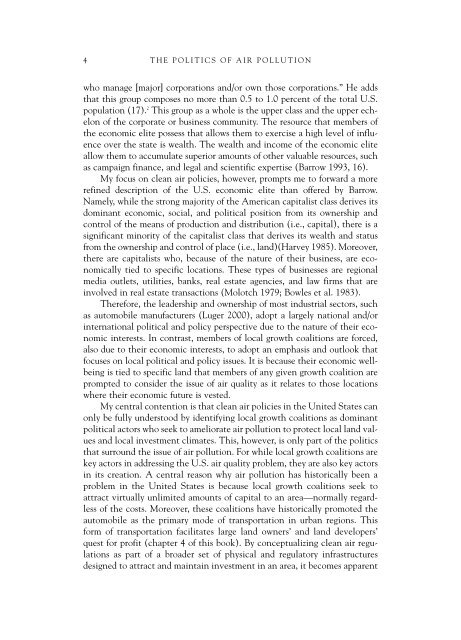GEORGE A. GONZALEZ - fieldi
GEORGE A. GONZALEZ - fieldi
GEORGE A. GONZALEZ - fieldi
You also want an ePaper? Increase the reach of your titles
YUMPU automatically turns print PDFs into web optimized ePapers that Google loves.
4THE POLITICS OF AIR POLLUTIONwho manage [major] corporations and/or own those corporations.” He addsthat this group composes no more than 0.5 to 1.0 percent of the total U.S.population (17). 2 This group as a whole is the upper class and the upper echelonof the corporate or business community. The resource that members ofthe economic elite possess that allows them to exercise a high level of influenceover the state is wealth. The wealth and income of the economic eliteallow them to accumulate superior amounts of other valuable resources, suchas campaign finance, and legal and scientific expertise (Barrow 1993, 16).My focus on clean air policies, however, prompts me to forward a morerefined description of the U.S. economic elite than offered by Barrow.Namely, while the strong majority of the American capitalist class derives itsdominant economic, social, and political position from its ownership andcontrol of the means of production and distribution (i.e., capital), there is asignificant minority of the capitalist class that derives its wealth and statusfrom the ownership and control of place (i.e., land)(Harvey 1985). Moreover,there are capitalists who, because of the nature of their business, are economicallytied to specific locations. These types of businesses are regionalmedia outlets, utilities, banks, real estate agencies, and law firms that areinvolved in real estate transactions (Molotch 1979; Bowles et al. 1983).Therefore, the leadership and ownership of most industrial sectors, suchas automobile manufacturers (Luger 2000), adopt a largely national and/orinternational political and policy perspective due to the nature of their economicinterests. In contrast, members of local growth coalitions are forced,also due to their economic interests, to adopt an emphasis and outlook thatfocuses on local political and policy issues. It is because their economic wellbeingis tied to specific land that members of any given growth coalition areprompted to consider the issue of air quality as it relates to those locationswhere their economic future is vested.My central contention is that clean air policies in the United States canonly be fully understood by identifying local growth coalitions as dominantpolitical actors who seek to ameliorate air pollution to protect local land valuesand local investment climates. This, however, is only part of the politicsthat surround the issue of air pollution. For while local growth coalitions arekey actors in addressing the U.S. air quality problem, they are also key actorsin its creation. A central reason why air pollution has historically been aproblem in the United States is because local growth coalitions seek toattract virtually unlimited amounts of capital to an area—normally regardlessof the costs. Moreover, these coalitions have historically promoted theautomobile as the primary mode of transportation in urban regions. Thisform of transportation facilitates large land owners’ and land developers’quest for profit (chapter 4 of this book). By conceptualizing clean air regulationsas part of a broader set of physical and regulatory infrastructuresdesigned to attract and maintain investment in an area, it becomes apparent









